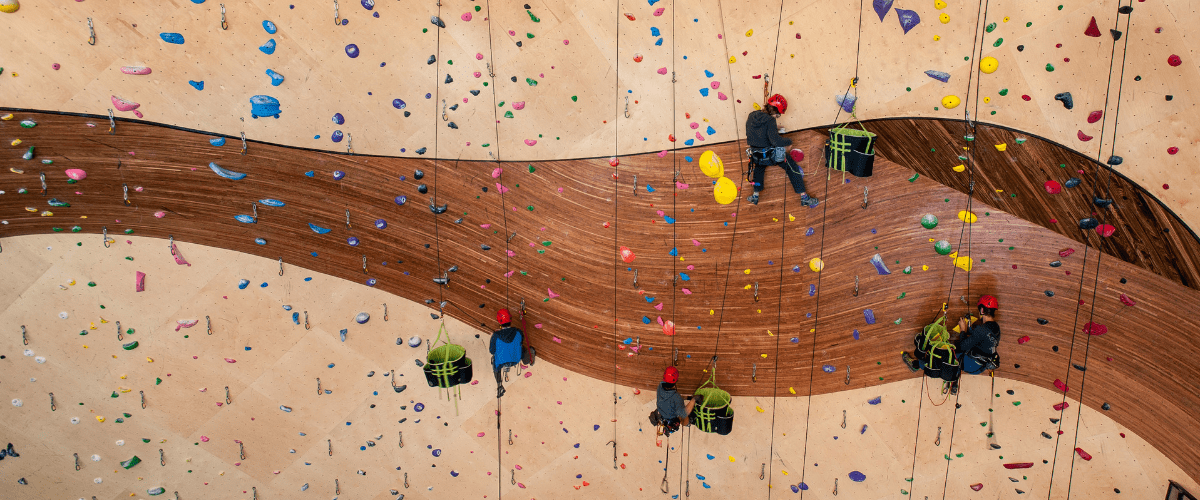Balancing the Business, Creativity, and Labor of Routesetting

As businesses, climbing gyms use business strategies, protocols, and methods to establish and operate the gym, but that approach doesn’t entirely work for routesetting. Unlike fitness gyms that use standardized equipment, climbing gyms are engaged in selling the climbing experience to members, which means routes and boulders set in the gym must emulate the very elusive concept of natural rock. Managing routesetting means balancing the business aspect, the creativity, and the manual labor. These are 3 distinct and very different skill sets, and it’s nearly impossible for anyone to be engaged fully in all 3 at the same time. The goal of managing a routesetting program is to engage the right staff, at the right time, in the right task, to the right degree.
Understanding Creativity, Business, and Labor
Creativity can be defined simply as creating something that didn’t exist before, ie: a new route or boulder in the gym. Inherently, creativity and productivity don’t mix and can be challenging in business. When you see a routesetter staring at a wall, many managers will think, “that person needs to do something.” But approaching routesetters and routesetting this way will only lead to frustration and conflicts. It’s important to know that it’s nearly impossible to see the creative process. People generate ideas in different ways, but research shows that ideas typically come when the mind is free and random thoughts can occur.
Business tasks on the other hand, unlike the creative process, are observable. It’s easy to tell when admin tasks are not completed. The business side of a routesetting program includes measurable tasks like placing orders, writing schedules and signing off on payroll – meaning you can determine the average amount of time it takes to accomplish these tasks. Of the three key elements to managing a routesetting program, the business side is the clearest cut, but due to the nature of the other aspects of the job, can present challenges.
The manual labor of routesetting cannot be measured in terms of productivity in the same way that other positions can be. This is due to the variable sizes and complexities of routes, and while the routesetter will have a plan of how they want to set the holds, there will be changes as the route takes shape on the wall. Furthermore, unexpected problems can arise that slow down the process, like a broken drill or a spinning t-nut. Additionally, routesetters often work outside of gym hours to set routes.
Creating a routesetting team that meets business goals, creates dynamic and fun routes that your members enjoy, and operates productively and efficiently can be a challenge to manage due to the unique skill set required for the position. Luckily, there are some approaches that can help.
Apply Strategic Thinking
Labor productivity research shows that the main characteristics influencing staff productivity fall into two categories: 1. age, skill, and experience, and 2. leadership and motivation. How you engage and interact with your team plays a significant role in determining the outcome. Identify the strategic requirements of the job – how does this job contribute to the overall mission and goal of the business? Then identify and prioritize the activities that would reach that outcome. Unfortunately for management and staff, the connection between their role and the strategic contribution they should be making is not always obvious, and losing track of this very important ideation can lead to poor productivity and skewed expectations. Simply put, your staff should be able to say the goal and objectives of their role as routesetters within the larger framework of the gym and know how their work directly affects the business.
Schedule Team Meetings Appropriately
While most of your staff probably keeps a regular schedule, routesetters may be setting after hours to avoid business interruption, which can lead to late nights. This may sound obvious, but expecting routesetters to attend early meetings after a late night or a re-set after a comp isn’t setting them up for success, pun intended. While team meetings are important and often need to occur right after events to recap, schedule them when they make sense and with consideration of when your routesetters usually pull shifts.
Cross Train on Varied Tasks
As an employer, don’t fall into the trap of a one-stop shop employee; sure, the idea of a creative routesetter/business wunderkind/workhorse sounds good, but as your gym grows, this approach limits what your staff can do and can lead to burnout. Be creative and do what works for your team; if you’re unsure of what your team needs, ask them for input. Cross-training the routesetting team on all the tasks that need to be accomplished for the business, while allowing them to develop skills and take on new responsibilities, will in turn support the strategic plan and growth of the gym.
Build Creativity Into the Schedule
We’ve already covered that creativity happens when the mind is free, so build in time for routesetters to be creative as a part of their job. Simply because you can’t see it doesn’t mean your business won’t benefit from the process that routesetters undertake to create routes; and they need to be compensated for their creativity. What does that look like at your gym? Ask your routesetters when and how they get their best ideas for routes, then include time for them on their schedule to foster and develop creativity. You’ll know it’s working when your gym members are happy with the routes and providing positive feedback.
Putting It All Together (PIAT)
Balancing creativity, labor, and business doesn’t have to be challenging once you know what you need to accomplish. Managing your team well means that you know the strategic objective of the job and the strengths and weaknesses of your team.
- Define Routesetting Strategically
- Identify and Prioritize Routesetting Tasks
- Schedule Meetings so Routesetters Can Participate
- Cross Train on Varied Tasks
- Schedule Time for Routesetters to Be Creative
About The Author
 Amanda Ashley is a writer, climber, and a climbing mom. From her early days spent training on the musty community woody in The School at the New River Gorge to training in modern mega climbing gyms all over the West, she's seen the rise of climbing gyms and the evolution of routesetting up close and personal for the past 20 years. Amanda writes about climbers, routesetting, changes in climbing movement and performance, and the climbing industry. Amanda's work has appeared in Climbing Magazine, Climbing Business Journal, and the Utah Adventure Journal.
Amanda Ashley is a writer, climber, and a climbing mom. From her early days spent training on the musty community woody in The School at the New River Gorge to training in modern mega climbing gyms all over the West, she's seen the rise of climbing gyms and the evolution of routesetting up close and personal for the past 20 years. Amanda writes about climbers, routesetting, changes in climbing movement and performance, and the climbing industry. Amanda's work has appeared in Climbing Magazine, Climbing Business Journal, and the Utah Adventure Journal.
